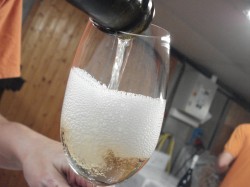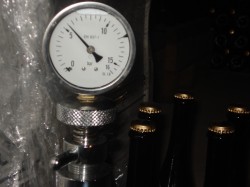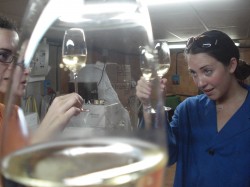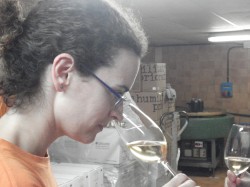
Today, we visited Mas Bertran, a family-operated winery in Sant Martí Sarroca, to learn more about how Cava is produced. Eva, the daughter, explained the process of making Cava from start to finish. After the grapes are harvested, they are put into a tank to mix. Next, the wine is bottled, capped, and placed in a large fixture in the winery’s dark, cave-like cellar. During the secondary fermentation, yeast and sugar are introduced. The second fermentation is what gives the wine its “sparkle,” creating Cava’s characteristic bubbles. The yeast also helps give structure to the wine.

Once this cube has formed, the cap of the bottle is popped off which shoots both the cap and the cube of sediment out of the bottle and into a large glass case. There is a massive amount of pressure within the bottle, so it is important to shoot the wine into the case and away from one’s face. The bottle is then placed in another machine that corks the bottle. It is now ready to be cleaned, labeled, and drank. Eva taught me that you must drink the Cava within 18 months of when it is disgorged or else the bubbles will escape and the cork will begin to go bad.
Tasting

We tasted both of the wines sold at Mas Bertran – the Balma and the Argila. I am not a wine expert, but I favored the Argila. Sergi explained that it has more body and more flavor since it is aged longer. You don’t taste the bubbles as much and it is smoother in the mouth. It can be used as an aperitif, or paired with the first or main course of any meal.
The Balma and Argila are produced using the same method. The difference between them lies in the type of grape that they consist of. The Argila is made from only one grape – the xarello. The Balma, on the other hand, is a combination between three grapes – 45% xarello, 30% marcabeu, and 25% parellada. Both Cavas are “Brut Nature,” meaning that the sugar is only added at the beginning, as food for the yeast. No sugar is added after the sediment has been taken out, so the Cava is very dry and not too sweet.

Kerrie Lopez, Wine Travel Writer for Wine Pleasures
Very interesting process. You’ll bring back a case or two for sampling stateside, no doubt!
In Alt empordà Girona, you can find, a very best wines and you can rest in http://www.llegendeshotel.com, a centric and charming hotel in Girona, near, the wine place.